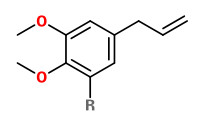Benutzer-Werkzeuge
Daucus carota subsp. carota L. - Apiaceae - wild carrot, Wilde Möhre
The woody taproot of the Central European wild carrot is white and carotin-free. Today's root vegetable, Daucus carota subsp. sativus is probably result of crossing with the Southern European ssp. maximus and the oriental ssp. afghanicus and cultivar selection.
http://www.biozac.de/biozac/capvil/Cvdaucus.htm
The most abundant constituents of the hydrodistilled oil obtained from plant umbels (Daucus carota L. ssp. carota) growing wild in Poland were α-pinene (41%), sabinene (18%), myrcene (7%), limonene (5%) and terpinen-4-ol (5%).
[Composition of the essential oil from wild carrot umbels (Daucus carota L. ssp. carota) growing in Poland. Staniszewska, M., Kula, J., Journal of Essential Oil Research, 13(6), 2001, 439-441]
„The essential oil of wild Daucus carota L. from Corsica… consisted chiefly of phenylpropanoids (45.9%) and monoterpene hydrocarbons (38.6%), with (E)-methylisoeugenol (33.0%), α-pinene (24.9%) and elemicin (11.4%) as major components… The oil yields, as well as the phenylpropanoid contents, particularly that of (E)-methylisoeugenol, increase significantly when the umbels ripen.“
[Identification of the components of the essential oil from wild Corsican Daucus carota L. using 13C‐NMR spectroscopy. Gonny, M., Bradesi, P., Casanova, J., Flavour and fragrance journal, Vol.19(5), 2004, 424-433]
„The essential oil of wild Daucus carota L. obtained from aerial parts at the end of the flowering stage (DCEO) was reported as antimicrobial against the human enteropathogen Campylobacter jejuni… Growth of all the C. jejuni, Campylobacter coli, and Campylobacter lari strains tested, including one multidrug resistant C. jejuni, was inhibited to the same extent by DCEO. Molecules that were responsible for the antibacterial activity were identified as (E)-methylisoeugenol and elemicin.“
[(E)-Methylisoeugenol and elemicin: Antibacterial components of Daucus carota L. essential oil against Campylobacter jejuni. Rossi, P. G., Bao, L., Luciani, A., Panighi, J., Desjobert, J. M., Costa, J., Berti, L., Journal of agricultural and food chemistry, Vol.55(18), 2007, 7332-7336]
„The essential oils and supercritical CO2 extracts of wild Daucus carota L. subsp. carota growing spontaneously in Sardinia and in Portugal were investigated. The main components in the Sardinian essential oil of flowering and mature umbels with seeds are β-bisabolene (17.6-51.0%) and 11-α-(H)-himachal-4-en-1-β-ol (9.0-21.6%); instead, the oils from Portuguese samples are predominantly composed of geranyl acetate (5.2-65.0%) and α-pinene (3.5-37.9%). Supercritical extracts contain lower amounts of monoterpenes and higher amounts of sesquiterpene hydrocarbons.“
[Chemical characterization and biological activity of essential oils from Daucus carota L. subsp. carota growing wild on the Mediterranean coast and on the Atlantic coast. Maxia, A., Marongiu, B., Piras, A., Porcedda, S., Tuveri, E., Gonçalves, M. J., Salgueiro, L., Fitoterapia, Vol.80(1), 2009, 57-61]
Daucus carota ssp.carota
© Rolf Marschner (2011),
www.botanische-spaziergaenge.at



